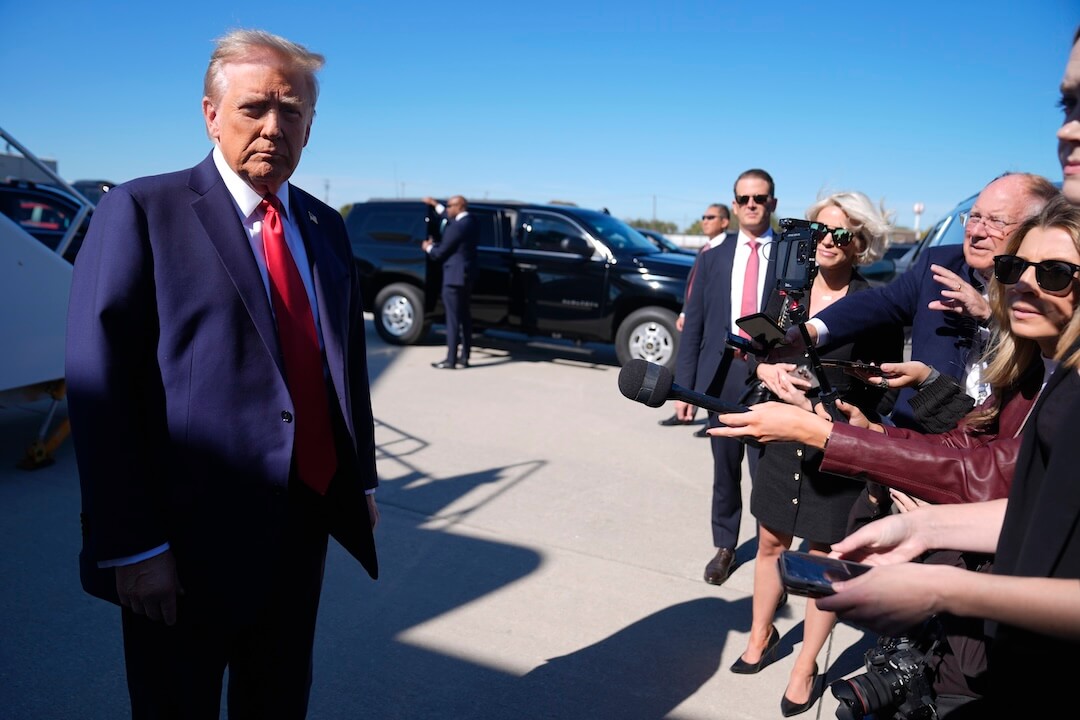Donald Trump doesn’t need news networks to broadcast his message to a million supporters. All he needs is a smartphone and a Facebook page.
This evening, the Republican nominee used Facebook Live to debut his “nightly campaign coverage” from Trump Tower. The show, broadcast from Trump’s official Facebook page, linked to a fundraising page for the Trump campaign.
Traditional campaign coverage this isn’t. The hosts included Tomi Lahren, a host on Glenn Beck’s The Blaze network and Cliff Sims, an adviser to the Trump campaign. Also on the livestream was Boris Epshteyn, a senior advisor to Trump campaign, a former contributor to U.S. News & World Report and political analyst for CNN.
The livestream, which began at 6:30 p.m., began with a conversation between Trump campaign manager Kellyanne Conway, Epshteyn and Sims. The conversation differed from traditional broadcast news in that it largely consisted of talking points from the Trump campaign and did not feature surrogates representing Trump’s opposition making counter-arguments.
The show included multiple segments bookended by breaks consisting of Trump speeches. The second segment consisted of a brief exchange between Sims and Epshteyn, followed by a message from Lahren, and the third segment was an interview with Republican National Committee spokesperson Sean Spicer.
Although “Trump Tower Live” lacks many staples of journalism — diversity of opinion, non-partisanship, tough questions — it did feature many design cues that made it look like traditional news. There was a crawler underneath the picture that displayed stories unfavorable to Hillary Clinton and favorable to Donald Trump. There was text superimposed over the feed that was reminiscent of traditional broadcast chyrons. And the hosts were dressed up in suits that invoked formal network attire.
Twenty-five minutes in, “Trump Tower Live” showed 29,000 concurrent viewers, which is far less than a traditional network news broadcast (which have viewership in the multiple millions) but more than some Facebook livestreams from major news organizations. By the time it ended at around 8 p.m., the broadcast had racked up 1.1 million views.
It was the latest demonstration of media savvy from a campaign that has proved adept at both ginning up free media coverage and reaching followers directly with platforms including Twitter and Facebook. Just last week, Trump scored more than 9 million views with a Facebook Live broadcast counterprogramming against major networks.
For months, Trump has been rumored to be considering the launch of a television network if defeated, a prospect that has become increasingly likely in recent weeks as his polling numbers have deteriorated. The campaign’s close relationship with several media figures — including Breitbart boss Steve Bannon (now Trump’s campaign chairman), New York Observer owner Jared Kushner (an advisor and son-in-law) and former Fox News chief Roger Ailes (an advisor) — would give Trump a deep bench if he went that route.
Tonight’s broadcast, however, isn’t that. In an interview with Wired, Epshteyn said the broadcast was merely an end-run around traditional media that the Trump campaign regularly rails against.
We all know how strong the left wing media bias is. This is us delivering our message to voters. It has nothing to do with Trump TV. It’s about using 21st century technology and communication in a way that’s effective.”
“Trump Tower Live” is another example of an increasingly popular tactic among political candidates. Both Trump and Clinton have built large media operations around themselves and are using them to push their agendas as the election approaches. Clinton has her own podcast and sections on her website devoted to fact-checking Trump. Trump is an inveterate Twitter user, has organized an armada of fact-checkers on social media and has a section on his website dedicated to negative stories about Clinton.
As my colleague Rick Edmonds notes, there is precedent in the broadcast world for using big news stories to launch shows. “Nightline” has its roots in a daily show dedicated to the Iran hostage crisis of 1979. “Newshour” also evolved out of gavel-to-gavel coverage of the Watergate hearings.
The similarities to real news end there, however, as was evidenced by a later stage of the broadcast. After another exchange, Epshteyn and Sims threw to a Trump rally in Tampa, where the candidate was speaking. The broadcast culminated a recitation of Trump’s talking points by allowing the candidate to reiterate them in front of a live audience.






